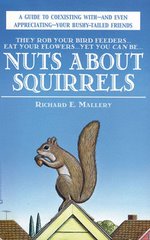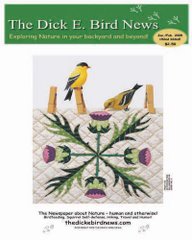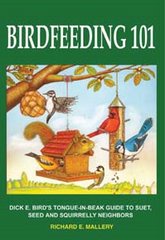
Sixteen months ago I decided I’d like to begin feeding birds, and my daughter bought me a feeder for Christmas.
Simple, right? Wrong.
I hung the feeder on my patio, where my cats and I could enjoy it, after filling it with sunflower seeds — because I’d heard that various birds like them.
No birds came to the feeder for months, so, last spring, I took down the feeder, washed it and started over.
This time sparrows found it, each day arguing over the seeds until the food was gone.
Squirrels, too, discovered it, realizing they could jump to the feeder from the fence. They hung onto the screened covering and worked their little mouths into the feeding ports, even though the feeder was "squirrel-proof."
When that activity wasn’t enough fun, they would leap onto the feeder as quickly as possible and make it twirl, scattering seeds all over the patio.
Black hulls lay everywhere — particularly messy after a rain.
I went to Wild Birds Unlimited to consult the experts, initially mentioning only the mess on my patio.
They recommended a no-mess seed, a wonderful fix for the patio disaster.
Yet the new seed drew more sparrows than before — and more squirrels.
I never saw any pretty birds.
In less than a day, the squirrels and sparrows could finish off a whole feeder of seed — and in less than two weeks, a 20-pound bag!
Back to the store I went to share my new problem.
I ended up buying a new feeder that is truly squirrel-proof: When the squirrels jump on it, the ports close.
I also switched to safflower seeds, which sparrows and squirrels don’t like.
I’d been missing out on the prettier birds, I learned, because those birds were wary of the aggressive sparrows that visited frequently.
Figuring that my problems were solved with my new feeder and new seeds, I waited patiently.
Unfortunately, no one told my sparrows and squirrels that they dislike safflower seeds.
They needed only a day to adjust, then returned in full force, going through a full feeder in 24 hours.
Granted, the seed is less expensive, but my patio is a mess again — albeit a white mess instead of a black one.
Still, I want to feed the birds.
Now I have a new problem: The squirrels have caught onto the port closings. So, instead of climbing onto the feeder, they ascend the nearby stucco wall and reach out to twirl the feeder, making the seeds spray like a sprinkler.
I think I have the smartest squirrels in Ohio.
Recently, I revisited Wild Birds Unlimited for more safflower seeds.
What about the squirrels? I asked.
The woman helping me suggested I buy shelled peanuts for them.
Rewarding the squirrels for poor behavior doesn’t seem right somehow, but she assured me she has the same issue.
She uses safflower seeds and a squirrel-proof feeder, and gives the squirrels 1 cup of peanuts a day.
Problem solved.
In the past few weeks, I have enjoyed visits from prettier birds — including a male and female cardinal, purple finches and chickadees on my feeder; and doves that eat seeds from the patio.
I still see sparrows, but they come much less frequently. (I think they have found "better" seed elsewhere.)
Surprisingly, the squirrels are behaving well, appreciating their daily peanuts and disregarding the bird feeder.
With the warmer weather, however, I have safflower plants sprouting in flowerpots below.
What’s more, sweeping the hulls and fallen seeds off the patio will probably be a daily ritual.
But I want to feed the birds, so I’ve decided it’s worth the trouble.
Simple, right? Wrong.
I hung the feeder on my patio, where my cats and I could enjoy it, after filling it with sunflower seeds — because I’d heard that various birds like them.
No birds came to the feeder for months, so, last spring, I took down the feeder, washed it and started over.
This time sparrows found it, each day arguing over the seeds until the food was gone.
Squirrels, too, discovered it, realizing they could jump to the feeder from the fence. They hung onto the screened covering and worked their little mouths into the feeding ports, even though the feeder was "squirrel-proof."
When that activity wasn’t enough fun, they would leap onto the feeder as quickly as possible and make it twirl, scattering seeds all over the patio.
Black hulls lay everywhere — particularly messy after a rain.
I went to Wild Birds Unlimited to consult the experts, initially mentioning only the mess on my patio.
They recommended a no-mess seed, a wonderful fix for the patio disaster.
Yet the new seed drew more sparrows than before — and more squirrels.
I never saw any pretty birds.
In less than a day, the squirrels and sparrows could finish off a whole feeder of seed — and in less than two weeks, a 20-pound bag!
Back to the store I went to share my new problem.
I ended up buying a new feeder that is truly squirrel-proof: When the squirrels jump on it, the ports close.
I also switched to safflower seeds, which sparrows and squirrels don’t like.
I’d been missing out on the prettier birds, I learned, because those birds were wary of the aggressive sparrows that visited frequently.
Figuring that my problems were solved with my new feeder and new seeds, I waited patiently.
Unfortunately, no one told my sparrows and squirrels that they dislike safflower seeds.
They needed only a day to adjust, then returned in full force, going through a full feeder in 24 hours.
Granted, the seed is less expensive, but my patio is a mess again — albeit a white mess instead of a black one.
Still, I want to feed the birds.
Now I have a new problem: The squirrels have caught onto the port closings. So, instead of climbing onto the feeder, they ascend the nearby stucco wall and reach out to twirl the feeder, making the seeds spray like a sprinkler.
I think I have the smartest squirrels in Ohio.
Recently, I revisited Wild Birds Unlimited for more safflower seeds.
What about the squirrels? I asked.
The woman helping me suggested I buy shelled peanuts for them.
Rewarding the squirrels for poor behavior doesn’t seem right somehow, but she assured me she has the same issue.
She uses safflower seeds and a squirrel-proof feeder, and gives the squirrels 1 cup of peanuts a day.
Problem solved.
In the past few weeks, I have enjoyed visits from prettier birds — including a male and female cardinal, purple finches and chickadees on my feeder; and doves that eat seeds from the patio.
I still see sparrows, but they come much less frequently. (I think they have found "better" seed elsewhere.)
Surprisingly, the squirrels are behaving well, appreciating their daily peanuts and disregarding the bird feeder.
With the warmer weather, however, I have safflower plants sprouting in flowerpots below.
What’s more, sweeping the hulls and fallen seeds off the patio will probably be a daily ritual.
But I want to feed the birds, so I’ve decided it’s worth the trouble.





